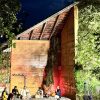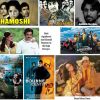Goa is abuzz with excitement as vintage bike and car owners, users, collectors and fans are decking […]

`NEVRI’ IS TO GOA WHAT `MODAK’ IS TO MAHARASHTRA…
Aug 30-Sept 05, 2025, Eating is Fun / Eating is Yuck! - A variety food column, Life & Living August 29, 2025Look for the two divine sweet something delights for the soul, nevri’ andmodak’ — come Ganesh Chaturthi, Chavath or Chovoth, as the birthday anniversary of Lord Ganesha is called Goa!
OVER the years of living in Goa I’ve discovered that what “nevri” (sweet or savoury crescent-styled crunchy) is to Goa, “ukadiche modak” (freshly steamed sweet rice flour dumpling) is to Goa. Both are very sophisticated snacks served up to the deity of Lord Ganesh installed beneath a gorgeous “matoli” of forest produce – flowers, fruit, herbs, vegetables, wild greens, etc. The matoli is very unique to Goa, this is a canopy of all kinds of amazing wild forest bounty. While in Mumbai which was Bombay in the 70s/80s/90s I became very familiar with the ukadiche modak which means steamed modak (there is also the fried version), but snowy white steamed modak are very delicate and you need skill to turn them out so beautifully that your mother or mother-in-law will rave about the magic in your fingers!
Nowadays you have moulds to turn out modaks, but in country homes you will see the women getting together to help make steamed modaks. It takes boiling water, stirring in the rice flour, turning out the dough; separately making the filling of grated coconut, palm jaggery, cardamom/nutmeg to highlight the flavor. The slightly hot cooked rice dough is massaged and with the hands neatly tapped out into thin white round “puri,” a tablespoon or teaspoon of the sweet filling tucked in the centre and then the edges fluted together neatly so you get a “potli” styled modak. After being served to Lord Ganesh at the family altar where a diya burns day and night, it is considered blessed and added in to all the batch of modak to be served to family members as the first sweet of the lunch meal. The still warm modak are served with a touch of pure ghee atop them – needless to say the women will discuss how finely or indifferently made they are.
THERE are all kinds of modak of course when Lord Ganesh comes home to rule the household for anything from one-and-a-half day to upto 11 and even 21 days (but the big affairs are only for the community or sarvajanik celebrations). Nowadays, you will find modak of all size from mini to maxi to real fatso versions made of reduced milk that is mava (sweetened), cashewnut or almond or pistachio paste, in vanilla, chocolate, cocoa, coffee flavors and much else. The caju and kesar caju modak are much relished and of course pricier. I usually get my most scrumptious mava modak from Sawant Bros down town Panjim, they’re made from browned sweetened mava and come all the way from Belgaum in Karnataka, this speciality modak are much in demand in Goa. The fried modak I don’t much care for despite the frying being in pure ghee although many like these pastry soft fried modak too.
If have one or two ukadiche modak during the celebration of Lord Ganesh I’m happy! In Goan homes a different menu will be cooked while Lord Ganesh is at home (before the final day vissarjan or freeing deity’s idol in a water body, be it the family well or nearest beachside sea waters…the menu pays particular attention to the leafy greens cooked for the day, for it’s the monsoons and there’re a variety of leafy greens to tempt the palate of Lord Ganesh (for after all he is the elephant god of Hinduism, perceived as the “remover of obstacles” and the god who is invoked first in every auspicious puja). Many are the folklore stories in praise of Lord Ganesh or Ganesha or Ganpati and all the other names by which he is eulogized in various aarti prayers…
BUT coming to that other Goan Chavath treat we have the nevri or neuros which are crescent shaped fryums mostly sweet stuffed but may also be savoury or “thikat” (spiced up). Nevri are come a lovely ivory and the crispy covering is made from a dough binding of maida, rava, ghee, bit salt. Thin rounds are rolled out, filling placed and the nevri folded, sealed at the edges and deep fried. When patiently made nevri are lovely and yummylicious, reminding one of a bit of “baklava” filling, in nevri too the filling is of semolina and dry fruit crumble. A bad nevri would be hard and tasteless. So just as there are modak and modak there are nevri and nevri.
GENERALLY speaking comparisons are odious but of course if anyone is offering me a slice of say the Portuguese time almond bol sans rival, I’d take it, relishing and marveling over it. But by and large what I would like to say is that our local or traditional sweet and savory snacks are usually more wholesome, as long as they are made with honest ingredients…I mean, a good besan ka ladoo is far more desirable than any piece of cake. Most besan ke ladoo will feature sugar but they can be mildly sweet and perfectly agreeable if done in pure desi ghee, spiked with cardamom/nutmeg and sometimes somebody likes to throw in a golden raisin or two. Besan ladoo are protein rich and I would say have more nutritional values than say …. goeey pastry or jammed over doughnut. I’m not talking all mithai but much of it is made of roasted gram flour or wheat or millet flour and oftentimes the sweetener is grated jaggery instead of refined white sugar. Nowadays one may also find date sugar.
The ladoo I consider as a national sweet something of India for they come in various avatar – think besan ladoo, rava ladoo, methi ladoo, dink ladoo, haleem ladoo, the most popular boondi ladoo of Tirupati prasadam temple fame, think motichoor ladoo, ukadiche red rice flour, also bajra ladoo can be very delicately fine textured and delicious. These days I’ve taken to buying 100% dry fruit ladoo (more expensive but just one is filling enough to take care of hunger pangs).
APART from Maharashtra’s ukadiche modak and Goa’s nevri, one may not close this without registering the much loved steamed sweet of “patoli” – fragrant and utterly welcome with its aroma of turmeric leaf in which the sweet is steam cooked. If ukadiche modak belongs to Maharashtrian households, the warm leafy green steamed patoli belongs to Goa and these are made in large quantities come the Ganesh, Deepavali and X’mas season one after the other as the year comes to end. Patoli is easier to make than ukadiche modak and both use the same ingredients of rice flour base and filling of freshly grated coconut and palm jaggery “choon” or mix. Both are meant to be served freshly made and still warm, no storing in fridge. This is to say if you haven’t discovered Goa’s nevri and patoli, do so this Ganesh celebration. The nevri interstingly is “karanji” in Maharashtra, “googra” in Gujarat, “gujiya” in Uttar Pradesh and Bihar…these crescent shaped sweets may be elegantly slim or fillingly fat and tightly packed with goodies – you’re your pick and enjoy your life!















